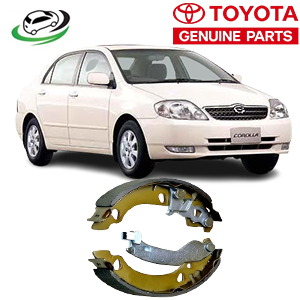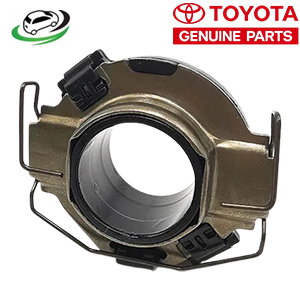-13%
Get Genuine Clutch Release Bearing Assy For 1KD-FTV / 2KD-FTV Engines 31230-71011 in Kenya
The clutch release bearing assembly plays an essential role in the operation of a manual transmission vehicle. It is a vital component in the clutch system, ensuring smooth engagement and disengagement of the clutch, and allowing the driver to shift gears with ease. The bearing is located between the clutch pedal mechanism and the pressure plate, facilitating the transmission of force when the clutch pedal is pressed.
In this detailed guide, we’ll explore the function, types, materials, common issues, installation, and maintenance of the clutch release bearing assembly.
1. Function of the Clutch Release Bearing Assembly
The clutch release bearing, also known as the throw-out bearing, is responsible for releasing the clutch when the driver presses the clutch pedal. This action disengages the engine from the transmission, allowing the driver to shift gears. The process can be broken down as follows:
- Pressing the Clutch Pedal: When the driver presses the clutch pedal, the clutch release bearing moves toward the pressure plate.
- Engaging the Pressure Plate: The release bearing pushes against the diaphragm springs in the pressure plate, which releases the pressure holding the clutch disc against the flywheel.
- Disengaging the Engine from Transmission: Once the clutch disc is separated from the flywheel, power from the engine no longer flows to the transmission, allowing the gears to be shifted.
- Returning to the Resting Position: When the clutch pedal is released, the clutch release bearing moves away from the pressure plate, allowing the springs to re-engage the clutch disc with the flywheel, and restoring the power transfer from the engine to the transmission.
The clutch release bearing must function smoothly to ensure consistent gear shifts without causing excessive wear to other components of the clutch system.
2. Types of Clutch Release Bearings
There are different types of clutch release bearings, each designed for specific vehicle applications and performance requirements. These types include:
- Mechanical Release Bearings: These are the traditional clutch release bearings that operate through a mechanical linkage. The driver’s input via the clutch pedal directly moves the bearing, which pushes against the pressure plate to disengage the clutch. Mechanical release bearings are simple and reliable but can require more maintenance due to wear and tear on the linkage system.
- Hydraulic Release Bearings: These bearings are part of a hydraulic system that replaces the mechanical linkage. Hydraulic release bearings are actuated by fluid pressure from the clutch master cylinder, which reduces the physical effort needed to operate the clutch pedal. This type is commonly found in modern vehicles because it offers smoother operation and requires less maintenance compared to mechanical bearings.
- Self-Adjusting Clutch Release Bearings: These bearings are designed to automatically compensate for wear in the clutch system. As the clutch wears over time, the bearing adjusts itself to maintain the proper distance between the clutch and the flywheel. This type can prolong the lifespan of the clutch system and provide more consistent performance over time.
3. Materials Used in Clutch Release Bearings
The clutch release bearing assembly is typically made of durable materials designed to withstand the high-stress environment of a vehicle’s clutch system. Common materials used in its construction include:
- Steel: The bearing itself is typically made of high-grade steel. Steel is chosen for its strength and ability to withstand the forces applied during clutch operation. The rolling elements inside the bearing, such as balls or rollers, are also made from hardened steel to reduce wear and friction.
- Carbon: Carbon composite materials may be used in high-performance clutch release bearings to reduce weight and improve heat resistance. Carbon materials can handle the high temperatures generated by repeated clutch use, making them ideal for racing or performance vehicles.
- Lubricants: The bearings are often lubricated with high-temperature grease to reduce friction and prevent wear. The lubrication is sealed inside the bearing, which ensures smooth operation and helps prevent premature failure due to heat buildup.
4. Common Issues with Clutch Release Bearings
Like any mechanical component, the clutch release bearing is subject to wear and failure over time. Recognizing the symptoms of a failing bearing early can help prevent further damage to the clutch system. Common issues include:
- Bearing Noise: A worn-out clutch release bearing often produces noise when the clutch pedal is pressed. The noise may sound like a grinding, squealing, or chirping sound. This occurs when the bearing loses its lubrication or develops excessive wear, causing metal-to-metal contact.
- Clutch Pedal Vibration: If the clutch release bearing is damaged, the driver may feel vibrations or pulsations through the clutch pedal. This indicates that the bearing is not rotating smoothly or is misaligned.
- Difficulty in Shifting Gears: A faulty release bearing can cause difficulty in shifting gears. The clutch may not fully disengage when the pedal is pressed, leading to grinding or resistance when trying to change gears.
- Premature Clutch Wear: A malfunctioning clutch release bearing can accelerate the wear of the clutch disc, pressure plate, or flywheel. If the bearing does not release the clutch properly, it may cause the clutch to slip or remain partially engaged, which can lead to premature wear.
5. Installation Process of a Clutch Release Bearing Assembly
Installing a clutch release bearing assembly requires precision and understanding of the clutch system. The process typically involves the following steps:
- Disassembly of the Transmission: The transmission must be removed to gain access to the clutch system. This often involves removing the driveshaft, clutch linkage, and various other components.
- Removing the Old Bearing: Once the transmission is removed, the old clutch release bearing can be taken out. Care should be taken to inspect the bearing for signs of wear or damage, as this can provide insight into any potential issues with the clutch system.
- Inspecting the Clutch System: Before installing the new bearing, it is important to inspect the pressure plate, flywheel, and clutch disc for any signs of wear or damage. Replacing a worn release bearing without addressing other issues in the clutch system can result in premature failure.
- Installing the New Bearing: The new clutch release bearing is installed in the same position as the old bearing. In the case of hydraulic systems, any necessary bleeding of the hydraulic lines should be done to ensure proper operation.
- Reassembly of the Transmission: Once the new bearing is installed, the transmission is reassembled, and the clutch system is tested to ensure proper operation.
6. Maintenance Tips for Clutch Release Bearings
Proper maintenance of the clutch release bearing is essential to prolong its lifespan and avoid costly repairs. Some key maintenance tips include:
- Regular Clutch Inspection: Regular inspections of the clutch system, including the release bearing, can help identify early signs of wear. If the clutch feels different or there is noise when operating the pedal, it’s important to check the bearing and related components.
- Proper Clutch Operation: Avoid riding the clutch, which means keeping the clutch pedal partially engaged while driving. This can cause excessive wear on the release bearing and the rest of the clutch system.
- Use the Correct Fluid: For vehicles with hydraulic clutch systems, it’s essential to use the correct hydraulic fluid and replace it at regular intervals. Contaminated or low-quality fluid can cause the hydraulic release bearing to wear out prematurely.
- Address Issues Promptly: If you hear noise or feel vibration when pressing the clutch pedal, it’s important to address the issue as soon as possible. Ignoring these symptoms can lead to more extensive damage to the clutch system.
7. Signs of a Failing Clutch Release Bearing
Knowing the early warning signs of a failing clutch release bearing can save you from more significant issues down the road. Here are some indicators to look out for:
- Squealing Noise: A high-pitched squeal when pressing the clutch pedal is a classic sign that the release bearing is worn and may need to be replaced.
- Hard Shifting: If the clutch is not fully disengaging, shifting gears may become difficult or result in grinding noises.
- Clutch Slippage: A worn release bearing may not disengage the clutch fully, causing the clutch to slip and reducing the vehicle’s ability to accelerate efficiently.
- Clutch Pedal Issues: If the clutch pedal feels spongy or stiff, it could be a sign of a failing hydraulic release bearing or linkage issue in mechanical systems.
8. Conclusion
The clutch release bearing assembly is a critical component in the smooth operation of a vehicle’s manual transmission. It plays a key role in allowing the driver to shift gears efficiently by disengaging the engine from the transmission when necessary. Available in mechanical and hydraulic variants, the clutch release bearing requires regular inspection and maintenance to ensure it functions correctly. Recognizing early signs of wear and failure—such as noise, vibration, or difficulty in shifting—can prevent more severe damage to the clutch system. Proper installation and maintenance, including regular fluid changes in hydraulic systems, will prolong the lifespan of the clutch release bearing and help ensure a smooth driving experience.
Follow us on Facebook for more parts.




Reviews
Clear filtersThere are no reviews yet.